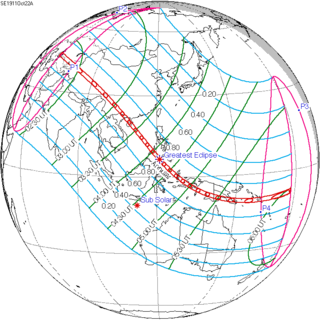| Solar eclipse of October 22, 1911 | |
|---|---|
| Type of eclipse | |
| Nature | Annular |
| Gamma | 0.3224 |
| Magnitude | 0.965 |
| Maximum eclipse | |
| Duration | 227 s (3 min 47 s) |
| Coordinates | 6°18′N 121°24′E / 6.3°N 121.4°E |
| Max. width of band | 133 km (83 mi) |
| Times (UTC) | |
| Greatest eclipse | 4:13:02 |
| References | |
| Saros | 132 (40 of 71) |
| Catalog # (SE5000) | 9307 |
An annular solar eclipse occurred at the Moon's descending node of orbit on Sunday, October 22, 1911,[1][2][3] with a magnitude of 0.965. A solar eclipse occurs when the Moon passes between Earth and the Sun, thereby totally or partly obscuring the image of the Sun for a viewer on Earth. An annular solar eclipse occurs when the Moon's apparent diameter is smaller than the Sun's, blocking most of the Sun's light and causing the Sun to look like an annulus (ring). An annular eclipse appears as a partial eclipse over a region of the Earth thousands of kilometres wide. Occurring about 5.75 days before apogee (on October 27, 1911, at 22:30 UTC), the Moon's apparent diameter was larger.[4]
Annularity was visible from the Russian Empire (the parts now belonging to Kazakhstan, Uzbekistan and Kyrgyzstan), China, French Indochina (the part now belonging to Vietnam), Philippines, Dutch East Indies (today's Indonesia), Territory of Papua (now belonging to Papua New Guinea) including the capital city Port Moresby, and British Western Pacific Territories (the parts now belonging to Solomon Islands and Tuvalu, including the city of Honiara and Tulagi). A partial eclipse was visible for parts of South Asia, Southeast Asia, East Asia, Australia, and Oceania.
- ^ "October 22, 1911 Total Solar Eclipse". timeanddate. Retrieved 31 July 2024.
- ^ "PARTIAL SOLAR ECLIPSE". The Daily Telegraph. Sydney, New South Wales, Australia. 1911-10-23. p. 8. Retrieved 2023-11-03 – via Newspapers.com.
- ^ "Solar Eclipse". The Morning Call. Allentown, Pennsylvania. 1911-10-23. p. 9. Retrieved 2023-11-03 – via Newspapers.com.
- ^ "Moon Distances for London, United Kingdom, England". timeanddate. Retrieved 31 July 2024.
